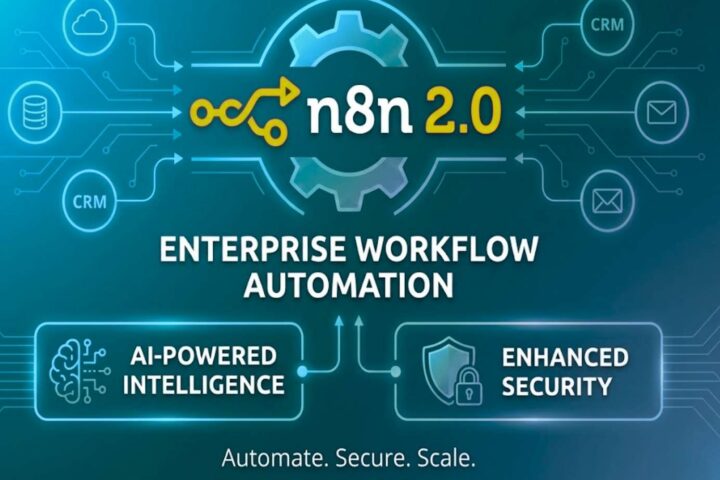Digital transformation is essential for businesses of any size to stay relevant and competitive in today’s market. Yet for a small business with a limited budget, it could sound like an intimidating undertaking.
What is Digital Transformation Strategy For Small Business?
Digital transformation strategy – is not about making your business digital, but ensuring that your business is prepared for the digital age.
The rise of social media and smartphones has not only changed the way we live and communicate but has also made the way we shop and conduct business.
Small businesses that fail to keep up with the changing trends risk falling behind and getting out of the game.
They may not need to be fast, but they need to be flexible.
Small businesses need to make bold decisions and take bold steps in order to stay relevant.
A digital transformation can look different for everyone and according to your current stage of business, your needs will vary from that of the other.
But what is common is that you need to make your business more relevant and more accessible for your customers.
This can be through improving your focus on social media, or improving your product quality, or even improving your website’s functionality, design or digital customer experience.
These are just a few examples of what you could consider but at the end of the day, it all boils down to what best fits your vision, your business goals and your audience.
Below is a list of 6 great strategies for digital transformation that you can use to get started:
- Website
In a digital age, it’s essential for your business to have a website.
And a great website will both make your customers happy and let your customers know that you are serious about your business.
In fact, when it comes to small businesses, there are various stats that suggest that having a website is even MORE important than having a brick and mortar shop!
You can use your website both as a tool to showcase your products (or services) and as a way to encourage customer engagement.
You don’t need to have a website designed specially by a professional website designer.
There are countless website builders out there today that allow you to build your own functional and beautiful website with minimal know how.
- Marketing
Your website is the face of your business. It’s your store front window, the sign for your shop and the place customers will land on when they search for your product or service online.
But without marketing, you may as well be just be hanging an empty sign on your window or just opening your store without any product!
Your website is the first step towards getting your business noticed online but you need to take it a step further.
In a digital world, there are a number of cost effective ways to market your business online – even with a limited budget.
Social media is the top platform for business marketing and to get you started, it might be a good idea to sign up to social media marketing tools that are competing for your business.
For paid marketing, you can start by using AdWords, Facebook Ads, Instagram etc.
For free marketing, you can begin by creating a presence for your business on Quora, Medium, Reddit or even on YouTube. If that sounds like a lot of work for you and your business, you can always hire a virtual assistant or even a professional marketing company to help you out.
- Ecommerce
To add to digital transformation strategy for small business, you can set up an online store.
Even if you are running a brick and mortar shop, your customers will certainly benefit from an online store that allows you to sell your products or streamline your services online.
This will allow you to reach a larger market and get in touch with more potential customers and internet users.
However, setting up an online store is no small feat. In fact, it could require investment on multiple fronts.
You may need to upgrade the system to a point of sale software, you may need specific ecommerce software and you may need to make some website changes to execute the way your store works online.
On top of that, you will also need a great online storefront that your customers will want to visit and a flexible way to connect you e-commerce software to a point of sale.
A point of sale (POS) software can help manage your inventory, customers, orders and roles while an e-commerce software provides a more adaptable way to create products for your online store.
For instance, you may be able to partially run your e-commerce software as a website, but why do you need a different website for your online store when you can design and manage it from your online e-commerce software?
- Social Media
Social media has become an important tool for small businesses to stay relevant in the world of digital transformation.
While an online website is all about showcasing your products/services, social media is all about connecting with your customers and reach out to new audiences.
Most social media platforms (at least the larger ones) have several different ways you can use them effectively for your business.
You can run your business’ social media accounts, you can hire someone to run your accounts, you can use social media marketing tools or you can outsource it all to a professional marketing agency.
This is a good way to see what works best for your business, but you need to start slow.
Rather than diving into social media, start with one platform (like Facebook or Twitter).
Then, learn the dynamics of the platform, test out a few strategies and then move on to using multiple platforms.
- SEO
SEO (Search Engine Optimization) is not something that is a priority in the transformation of digital businesses, yet it is often the first step in making your business intuitive, highly usable, and easily found online.
Web design must be optimized in order to make your site functional and be easily found by users through search engines.
This is where SEO comes in. It will help your website rank higher on search engines so that your business is more visible to both new and existing customers.
This is a great way to save marketing costs while also increasing customers.
To ensure your website ranks high in the search engines, there are five key items you need:
- Great content (on your page and in your blog)
- A functional and easy to navigate website
- A strategic website architecture
- Good design principles
- Good internal link structure
All of these elements are key to having a well optimized website that is easy to find and has an abundance of relevant content/links that will in turn drive traffic to the site.
- Digital Tools
There are many digital tools that can help you transform your business and optimize your day to day operations.
These can be used both internally (on your own business) as well as externally (outside of your business).
Tools such as email services like Gmail, accounting services like Quickbooks, cloud storage services like Dropbox, market automation tools like Marketo and web services like SurveyMonkey can be very useful in optimizing and executing digital transformation of small business.
There are also numerous business apps that can be very effective in the future of business automation and growth.
If you’re not sure you want to invest the time in developing an internal tool, then leveraging your team through market automation tools or by hiring new employees with business apps will definitely help.
You don’t need to invest in business apps or market automation tools – but rather just be informed about them.
This way you can understand what each tool/service offers and make sure it fits in with your business.
How to build a Digital Transformation Strategy For Small Business
- Define Digital transformation success
This is the first thing that you need to do when creating your digital transformation strategy for small business.
What metrics and pillars of your company will you use to gauge success?
You will need to articulate what success looks like to ensure you set realistic and measurable goals.
Before you begin, take time to set SMART (Specific, Measurable, Achievable, Relevant and Timely) goals. These should focus on the type of shifts that you want to make within your business and the kind of changes that will indicate your business is undergoing digital transformation.
- Assess digital transformation
You also need to assess your current website, internet presence (and social media presence), how your employees market your business, draw a picture of how you want your business and your brand to grow and determine the areas of improvement you need to make.
- Identify the Need
Next, you will need to narrow down the goals of your digital transformation strategy for small business.
You should also identify an area of improvement that can be addressed and eventually transformed into a measurable goal for your business in terms of revenue, rankings, leads, etc.
Ask yourself what is most important to your business and brand.
Next, brainstorm what digital transformations that you can test or implement to drive more revenue, get more leads or make your business more efficient. Once you have identified the few items or ideas that you feel need to be addressed, take some time to prioritize them and rank them against each other.
- Propose a Plan
Once you have determined what the goals of your digital transformation are, you will need to create an action plan (strategic plan).
In the plan you will need to explain:
- What is the best way to achieve the goal
- Who will be responsible for each part (in your company)
- What kind of resources you will need
- The timeline for each action to be completed
- Implement and Measure
After you have created the an action plan for your digital transformation strategy for small business, you will need to implement it.
The same goes for your digital marketing strategies.
There is a difference between the strategy you created and the action plan you made.
Nowadays, “strategy” is defined as a description of the direction an organization intends to pursue in the future to satisfy its customers.
This is how you define your strategy.
Then you have to create an action plan based on your goals and how you are going to achieve them.
Never forget to measure and to test everything you have done.
Test, iterate, analyze, measure, and then continue the process of digital transformation because it is never ending.
Never stop improving – sure, it requires a lot of work constantly analyzing and measuring to achieve the goals you seek, but in the end, digital transformation of small business is worth it.
It’s important to understand that the digital transformation of business may take some time, but you want to be patient and work towards creating mutually beneficial graphs.
Things to Consider When Developing a Digital Transformation Strategy for Small Business
When planning for digital transformation of your small business, it is important to consider several key factors.
These considerations will hopefully help you to create a successful transformation plan that will help your small business thrive.
We will say in a later point, be realistic with your goals.
These considerations are:
- Constant changes in digital transformation
Nowadays, we see changes in digital transformation on a constant basis.
Everything is connected to data and there is a lot of data flowing by.
Change in digital transformation has widely affected businesses of all sizes.
This will affect your business as well, meaning your strategy will probably need to change after some time.
- It is hard to predict the future
Because of constant changes in digital transformation, it is hard to predict and expect the future.
If you want to survive in business you will need to make changes to your business and internal structure and to your strategy.
These changes include everything from changing your business development to re-designing your website.
Constant changes in digital transformation mean you will probably need to change your digital marketing strategy and your business structure many times over.
- Invest in your employees
One of the most important elements to successful digital transformation of a business is its employees.
Although, as we said before, it is not the main key element.
It is more like navigating tool.
Your employees are important because they connect your business to your customers. They are the link that leads you to the place where you get more traffic from, to make your business show up on first page on Google or to get more leads and engage with your customers.
Without employees, even the most reliable and advanced techno-solutions will be useless.
It is your employees who will help you navigate if you want to go for a positioning strategy or a positioning strategy, if you want more leads or more traffic, and if you need more sales or more conversions.
The value of your employees is what will make or break your business.
- Work on a clear strategy
Every business is different, and what works for one business may not work for another.
It is important to remember that every business has its own unique character and needs to be treated differently as well.
One of the most important aspects of the digital transformation strategy, therefore, is understanding the needs of your business.
You need to understand how the customers of your business work, what they do and how they react to the changes. This will help you make important decisions when it comes to your digital transformation strategy.
Understand your target audience and your potential market, and how they work.
For example, what kind of customers do you have, do they buy online, and if they buy online do they mainly use mobile, desktop or both.
You can improve your digital marketing strategy and change the way your customers interact with your business if you think about how they work or how they choose to interact with you.
Make sure your digital transformation strategy will focus on your business, its customers and their needs.
- Be realistic with your goals
You can be idealistic with your goals, but it is important to remain realistic. Idealism inspires, and when you remain idealistic you can never go wrong.
Yet if you are unrealistic with your goals, you will most likely fail and you are going to waste a lot of resources and time.
For example, if you sell cars, it makes sense to invest in SEO if you want a long-term result. If you open a coffee shop, don’t expect it to bring you a lot of improvements in terms of more traffic and higher conversion.
Sometimes we can get a little carried away with success stories and for some reason we expect our business to be as successful as it is, even though it is not the same business.
Always think about your goals, and always think about common sense before you start looking at what other businesses are doing and what they are not doing.
For example, if you don’t have a lot of leads and if you don’t have a lot of traffic, it makes sense to focus on those 2 things first, according to our software.
Make clear plans for Google Analytics and Google Search Console, as well as clear plans for Google AdWords.
These are the actions you can take in order to increase traffic and leads, and therefore increase sales.
Never be quick to judge. Always make sound judgments, and always be somewhat realistic when planning your digital marketing strategy.
- Build a strong brand
When it comes to a digital business transformation, build a brand is one of the most important elements of success.
It’s like Michelangelo said: “Every block of stone has a statue inside it, and it is the task of the sculptor to discover it“.
Every business has a brand. Every brand has a unique set of values and a unique philosophy.
For example, Zara, in our opinion, has a good brand, and we can say this because we have seen and experienced it.
Zara has a pretty strong brand that has a good visual identity, and a good visual identity can be important for small businesses as well.
Think of your brand in terms of customer satisfaction. Think of your brand in terms of how your customers think about your business in general, and how your business needs to interact with them.
Plan your digital transformation strategy according to your brand, think about how you need to stand out from your competitors, and think about how you need to interact with your customers.
- Remember your customers’ needs
Customers are at the top of the hierarchy when it comes to building a successful brand and eventually successful business.
In our opinion, it is the customers that define the success of your business.
It is your customers that will determine if your brand is good or not.
As we said before, understanding your target audience and your potential market, and how they work, is necessary so you can make your business grow.
All business ideas and digital transformation strategies start from your customers.
For example, if your customers are going to Google search for “socks”, it is your duty to make yourself more visible, in order to generate more leads, the right leads and sales.
It is your duty to learn about your position in various search engine results, in order to promote your business and make a profit and it is your duty to engage with your customers.
Have a clear idea and strategy for each one of these tasks.
- Make your company more usable and more transparent
Remember that you are not a business anymore, but an E-commerce company.
Customers need to be able to purchase your products or services online.
You need to deliver your products and services digitally, and make sure that you deliver the best product or service possible.
In order to do this, it is important that you fix any usability issues, and make sure that your website is designed for the purpose of selling your products and services.
Remember to make your company more transparent. Transparency is vital in this day and age.
You want to make sure that your business is ethical, and at the same time you want to make sure that your business is competitive and it is worth being recommended.
In our experience, being transparent has helped our business a lot over the years, and we recommend it for every business owner who is serious about improving their business.
- Automate processes
One of the most important elements to the success of your digital transformation of your business is automation.
You need to automate processes and make sure your core business is automated.
For example, if you gain traffic on your website, and if you get qualified traffic from automated websites, your business is automatically going to succeed.
It is very important to have a clear idea of which processes you want to automate, and which processes you want to not automate.
You also need to have clear ideas about how you want to automate the processes, and how you want to interact with your customers.
It’s like 3 on our software. 3 is a good number, because we want to make sure that the process is very clear and it is easy to understand for your customers.
Think about automation, because it is one of the most important elements in achieving a stronger business.
- Implement an incentive program
Don’t forget about your employees.
It is important to think about your employees as well, and to think about them in terms of loyalty.
This means that your employees deserve to be paid fairly, and they deserve to be rewarded from time to time.
For example, you can implement a referral program, or an incentive program, where you reward your employees if they bring value to your business or if they bring you qualified traffic and leads.
Make sure you implement as many incentive programs as possible, because they are really important to the success of your business.
It is important that your employees are committed to your business, and that you have a clear idea about how you are going to motivate your employees.
Conclusion: 10 Rules to Digital Transformation
The digital marketing training in 10 simple rules are not difficult to understand, even though there are many different factors that can affect your digital business.
It is true that we cannot fit the digital transformation process into a box, and it is true that you cannot apply the same process to many different kind of businesses.
We recommend that you start from the beginning.
Try to understand whether your website is user friendly, and if your website is going to function well.
Try to understand whether your website is doing well in terms of traffic and leads, as well as conversions, and have clear ideas about what needs to be changed.
Once you have done this, you can try to take if further.
You can start applying the rules.
We hope that this article has been useful, and we hope that you have found a lot of value from it.
Think about your business, and think about the value you can give to your business.
For example, once you have implemented the above strategies and rules, you will be able to know more information about your business, and your business will be able to generate sales, leads, traffic and eventually leads to sales.
Remember that online marketing is important in this day and age.
It is important that your business operates online, and it is important that your business has a good online presence.
Make sure that you plan your online business according to these 10 rules, because it will improve your chances of success exponentially.















